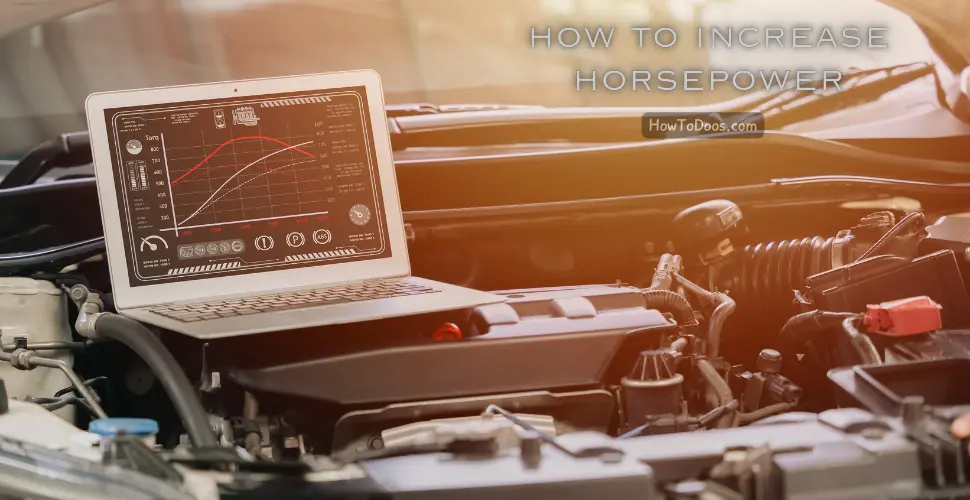How to Increase Horsepower – A Comprehensive Guide to Boosting Engine Performance
-
 James Mitchell
James Mitchell - 03 Sep, 2024

Increasing the horsepower of your vehicle can enhance its performance, responsiveness, and overall driving experience. Whether you’re a car enthusiast looking to maximize your car’s potential or someone interested in improving your vehicle’s capabilities, understanding how to increase horsepower is crucial. This comprehensive guide will explore various methods, parts, and considerations for boosting engine performance.

Understanding Horsepower
What is Horsepower?
Horsepower is a unit of measurement used to quantify the power of an engine. It represents the engine’s ability to perform work over time. One horsepower is defined as the ability to do 550 foot-pounds of work per second. Essentially, horsepower measures how quickly an engine can do work, which translates to how fast a vehicle can accelerate and reach high speeds.
How Horsepower Affects Performance
Horsepower directly impacts a vehicle’s performance. Higher horsepower typically means:
- Faster Acceleration: More power allows a vehicle to accelerate more quickly.
- Higher Top Speed: Increased horsepower can lead to higher maximum speeds.
- Better Towing Capacity: More power can improve the vehicle’s ability to tow heavy loads.
- Improved Performance: Enhanced horsepower can lead to better overall driving dynamics.
Methods to Increase Horsepower
1. Engine Tuning and ECU Remapping
What is Engine Tuning?
Engine tuning involves adjusting the engine’s settings to optimize performance. This can be done through ECU (Engine Control Unit) remapping, which modifies the software that controls engine functions such as fuel injection, ignition timing, and boost levels.
Benefits of ECU Remapping
- Increased Power Output: Remapping the ECU can lead to significant gains in horsepower by optimizing engine parameters.
- Improved Fuel Efficiency: Proper tuning can also enhance fuel economy by making the engine more efficient.
- Customization: Tuning allows you to tailor the engine’s performance characteristics to your specific needs.
How to Remap the ECU
- Find a Reputable Tuning Service: Look for a professional tuner with experience and a good reputation.
- Get a Custom Tune: A custom tune is tailored to your vehicle’s specific setup and requirements.
- Test and Refine: After the initial remap, test the vehicle and make any necessary adjustments.
2. Upgrading Air Intake Systems
Why Upgrade the Air Intake?
The air intake system is responsible for delivering air to the engine. Upgrading the air intake can improve airflow, which can lead to increased horsepower. A high-performance intake system can reduce air resistance and increase the volume of air entering the engine.
Types of Air Intake Upgrades
- Cold Air Intakes: These systems draw cooler air from outside the engine bay, which can improve performance.
- High-Performance Filters: Upgrading to a high-performance air filter can improve airflow and filtration.
- Ram Air Intakes: These systems use the vehicle’s forward motion to force air into the engine, increasing intake pressure.

Installation Tips
- Choose the Right System: Select an intake system that is compatible with your vehicle and performance goals.
- Follow Manufacturer Instructions: Ensure proper installation by following the manufacturer’s guidelines.
- Maintain Regularly: Keep the air filter clean and replace it as needed to ensure optimal performance.
3. Upgrading the Exhaust System
How Exhaust Systems Affect Horsepower
The exhaust system plays a crucial role in removing exhaust gases from the engine. A high-performance exhaust system can reduce backpressure, which allows the engine to expel gases more efficiently and improve horsepower.
Types of Exhaust Upgrades
- Cat-Back Exhaust Systems: These replace the exhaust system from the catalytic converter to the rear of the vehicle, improving flow and performance.
- Headers: Upgrading to performance headers can reduce exhaust restriction and improve engine efficiency.
- High-Performance Mufflers: These can enhance exhaust flow and provide a more aggressive sound.
Installation Tips
- Choose a Quality System: Opt for exhaust systems made from high-quality materials for durability and performance.
- Ensure Proper Fitment: Verify that the exhaust system fits your vehicle correctly to avoid leaks and performance issues.
- Professional Installation: Consider having a professional install the exhaust system to ensure proper setup.
4. Turbocharging or Supercharging
What Are Turbochargers and Superchargers?
Turbochargers and superchargers are forced induction systems that increase the amount of air entering the engine, allowing for more fuel to be burned and resulting in increased horsepower.
- Turbochargers: Use exhaust gases to spin a turbine that compresses air and forces it into the engine.
- Superchargers: Use a belt-driven compressor to force air into the engine.
Benefits of Forced Induction
- Significant Power Gains: Both turbochargers and superchargers can provide substantial increases in horsepower.
- Improved Acceleration: Forced induction can lead to faster acceleration and better overall performance.
Installation Tips
- Choose the Right Kit: Select a turbocharger or supercharger kit designed for your vehicle’s make and model.
- Consider Supporting Mods: Additional modifications, such as upgraded fuel injectors and intercoolers, may be necessary.
- Professional Installation: Forced induction systems require precise installation and tuning, so professional help is recommended.
5. Upgrading Fuel System Components
Importance of Fuel System Upgrades
An upgraded fuel system ensures that the engine receives the appropriate amount of fuel for increased horsepower. This includes components such as fuel pumps, fuel injectors, and fuel pressure regulators.
Types of Fuel System Upgrades
- High-Performance Fuel Pumps: Provide increased fuel flow to support higher horsepower.
- Upgraded Fuel Injectors: Deliver more fuel to the engine, which is necessary for higher power levels.
- Fuel Pressure Regulators: Maintain consistent fuel pressure, ensuring optimal performance.
Installation Tips
- Select Compatible Parts: Ensure that the fuel system components are compatible with your vehicle and performance goals.
- Proper Tuning: After upgrading the fuel system, tuning the engine is essential to achieve optimal performance and reliability.
- Regular Maintenance: Keep the fuel system components in good condition to ensure consistent performance.
6. Engine Internal Modifications
Types of Internal Modifications
Internal engine modifications can enhance performance by improving engine components and efficiency. Common modifications include:
- High-Performance Camshafts: Improve valve timing and lift for better airflow.
- Forged Pistons and Connecting Rods: Increase durability and strength to handle higher power levels.
- Ported and Polished Cylinder Heads: Improve airflow and combustion efficiency.
Benefits and Considerations
- Increased Power: Internal modifications can provide significant horsepower gains.
- Improved Reliability: Upgraded components can enhance engine reliability and longevity.
Installation Tips
- Professional Installation: Internal modifications require precise installation and tuning, so professional assistance is recommended.
- Compatibility: Ensure that modifications are compatible with your engine and other performance upgrades.
- Tuning: After internal modifications, proper tuning is essential to achieve optimal performance.
7. Weight Reduction
How Weight Reduction Affects Horsepower
Reducing the vehicle’s weight can improve performance by making the engine’s power more effective. Weight reduction can lead to better acceleration, handling, and overall driving dynamics.
Methods of Weight Reduction
- Removing Unnecessary Components: Remove non-essential parts or accessories to reduce weight.
- Lightweight Materials: Use lightweight materials, such as carbon fiber or aluminum, for components like wheels and body panels.
- Stripping the Interior: Removing interior components, such as seats and soundproofing, can reduce weight.
Considerations
- Impact on Comfort: Weight reduction may affect vehicle comfort and practicality.
- Balance and Handling: Ensure that weight reduction does not negatively impact the vehicle’s balance and handling.
Maintaining Increased Horsepower

Regular Maintenance
Maintaining increased horsepower requires regular upkeep to ensure that performance improvements are sustained. Key maintenance tasks include:
- Routine Inspections: Regularly check engine components, fluids, and performance parts.
- Tuning and Calibration: Periodically retune the engine to account for changes in performance and ensure optimal operation.
- Clean Air and Fuel Filters: Keep air and fuel filters clean to maintain efficient engine performance.
Monitoring Performance
- Performance Testing: Use performance testing tools to monitor horsepower and ensure that modifications are delivering the desired results.
- Data Logging: Utilize data logging equipment to track engine performance and identify any issues or areas for improvement.
Conclusion
Increasing horsepower involves a combination of tuning, upgrading components, and optimizing engine performance. From ECU remapping and air intake upgrades to turbocharging and internal modifications, there are numerous methods to enhance your vehicle’s power output. By carefully selecting and implementing these strategies, you can achieve significant performance gains and enjoy a more powerful driving experience.
When pursuing horsepower improvements, it is essential to consider the impact on vehicle reliability, fuel efficiency, and overall driving dynamics. Regular maintenance and monitoring are crucial to ensure that your performance upgrades continue to deliver the desired results.
By following this comprehensive guide and focusing on quality parts and professional installation, you can effectively increase your vehicle’s horsepower and enjoy enhanced performance on the road.
